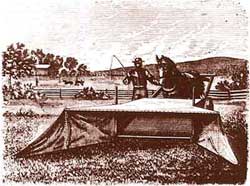Students will examine an original engraving of the Grasshopper Catcher, circa 1870. This unique piece of equipment was designed to assist the 19th century farmer fighting grasshopper plagues. Clues to the interpretation of this photograph will lead students to develop hypotheses regarding the function of this unique piece of equipment. Created to remedy the destructive results of grasshopper infestation, this device was but one of many developed during the latter part of the 19th century.
Early settlers of Iowa, faced with frequent (in some places annual) infestations of grasshoppers and locusts, combated the insects with whatever tools and techniques proved effective. These remedies included the grasshopper catcher pictured in this activity. Other attempts to neutralize the negative effects of the insect plague included the 'hopper dozers' and locust crushers that smashed the insects. Early season fires sometimes destroyed the larvae. Some farmers tried dragging long ropes across the fields to disrupt the insects, and other farmers simply turned to raising stock as opposed to raising grain crops.
It was reported that grasshoppers and locusts plagued the state, especially the northwestern quarter, nearly every year between 1868 and 1880. These plagues caused some farmers to abandon their homesteads especially after two very difficult years, 1873-1874. Despite these problems, this kind of adversity also inspired the creative genius and tenacity that characterized the people of the frontier. The grasshopper catcher is but one example.
 More background information may be found at Briggs, John E. The Grasshopper Plagues in Iowa, The Iowa Journal of History and Politics, Vol. 13, (1915), pp. 349-391.
More background information may be found at Briggs, John E. The Grasshopper Plagues in Iowa, The Iowa Journal of History and Politics, Vol. 13, (1915), pp. 349-391.
Who Was Rube Goldberg?
Rube Goldberg, (1883-1970), was a Pulitzer Prize winning cartoonist, sculptor, and author. Rueben Lucius Goldberg (Rube Goldberg) was born in San Francisco. His father insisted he go to college to become an engineer, but his real love was drawing and particularly drawing cartoons. Rube made a name for himself after moving to New York City where he drew daily cartoons for the Evening Mail.
Rube's trademark was discovering hard ways to achieve easy results. His cartoons were as he said, symbols of man's capacity for exerting maximum effort to accomplish minimal results. Rube believed that there were two ways to do things, the simple and the hard way, and that a surprisingly number of people preferred doing things the hard way.
Today, the name Rube Goldberg has come into common use as a general descriptor for any over-complicated mechanical device or invention.
In the Invention Convention activity students will evaluate the extent to which the Grasshopper Catcher might be considered a "Rube Goldberg." This exploration will serve as a starting point to explore the world of inventions.

Copyright © 2022 CampSilos | All Rights Reserved
National Standards | Silos & Smokestacks | Credits | Awards
Crafted by IFC Studios, a midwest Branding Agency.